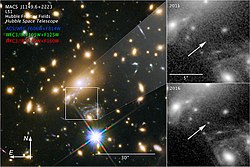V357 Muscae

| Observation data Epoch J2000 Equinox J2000 | |
|---|---|
| Constellation | Musca |
| Right ascension | 11h 26m 12.20s[1] |
| Declination | −65° 31′ 08.6″[1] |
| Other designations | |
| Nova Mus 2018, PNV J11261220-6531086[1] | |
| Database references | |
| SIMBAD | data |

V357 Muscae was a bright nova (Nova Muscae 2018) in the constellation Musca.[2] It was discovered on January 14, 2018 by Rob Kaufman of Bright, Victoria, Australia with a magnitude of 7.0.[3]

As well as being observed optically, the nova was also detected at radio wavelengths using the Australia Telescope Compact Array.[5]
See also
[edit]References
[edit]- ^ a b c "NOVA Mus 2018". SIMBAD. Centre de données astronomiques de Strasbourg. Retrieved 29 May 2018.
- ^ Kazarovets, E. V.; Samus, N. N. (2018). "Novae in 2018: Official Announcement of GCVS Names". Peremennye Zvezdy. 38 (5): 5. Bibcode:2018PZ.....38....5K.
- ^ "Alert Notice 609: Nova Muscae 2018 - PNV J11261220-6531086". Retrieved 2018-01-15.
- ^ Walter, Frederick M. (2016). "Nova Mus 2018 (PNV J11261220-6531086) Is Forming Dust". The Astronomer's Telegram. 11298: 1. Bibcode:2018ATel11298....1W. Retrieved 1 February 2022.
- ^ Ryder, S D; Kool, E C; Chomiuk, L. "Radio Detection of Nova Muscae 2018". The Astronomer’s Telegram. Retrieved 25 September 2018.
Sources
[edit]- PNV J11261220-6531086: nova (7 mag) in Musca (discovered by Rob Kaufman)
- CBAT "Transient Object Followup Reports"
- CBET 4472 "NOVA MUSCAE 2018" (access limited)
- "Alert Notice 609: Nova Muscae 2018 - PNV J11261220-6531086"


